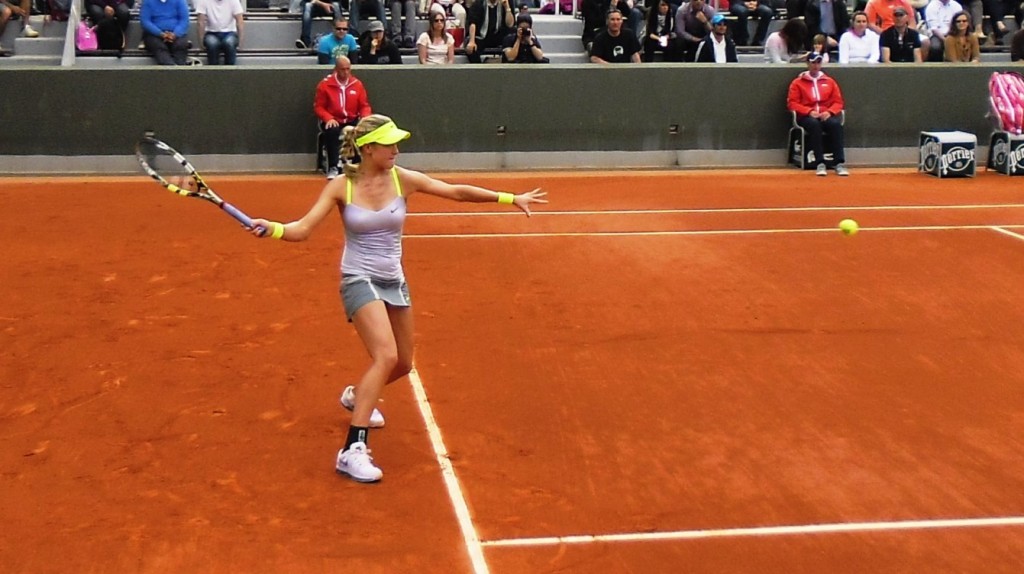It was around 4:45 PM in Paris when Andrea Petkovic and Sara Errani began warming up for their match on Philippe Chatrier and Svetlana Kuznetsova and Simona Halep began theirs on Suzanne Lenglen. Nobody at that time believed that all four quarterfinals scheduled on both courts would end by the end of the day. Yet, approximately five hours later, the semifinals on both draws were set. How did it happen?
This was the worst possible day for the rain to make a comeback. In every Slam tournament, this topic comes up. One side of the draw plays one day and the other side plays the next day. At some point in the second week, in order to bring all the rounds together to the same level, the players on one side of the draw get an extra day of break because the side that has been coming from behind needs a day to catch up and a day of rest. At Roland Garros this transition is executed between the quarterfinals and the semifinals. Today happened to be the day where the matches on the side of the draw that has been a day were to be completed in order to play the semifinals on the same day. If rain delays the matches, you sweat bullets as tournament organizers because you are left with players who will not get a day of rest playing against others who have been resting a day, or even two on the men’s side. Thus, you can imagine how worried they must have been around mid-afternoon when it was raining cats and dogs at Roland Garros.
However, they received help. Twice!
First help arrived when the rain that stopped around 4:30 PM, still allowing – thanks to Paris where it truly gets dark after 10 PM – over 5 hours of tennis-wise-safe daylight to get one women’s and one men’s match in on each court. Next help, though unintentional of course, came from the players. Petkovic and Halep defeated their opponents with identical scores, 6/2 6/2, in less than 1 hour and 20 minutes. The turnover from the end of the two women’s matches to the beginning of the two men’s matches was probably realized in record time. The usual end-of-the-match, on-court interviews with French TV were canceled (Halep looked like she had absolutely no problem with that), and even though they were not told directly, the movements of the ball boys and the referees made it very clear to the women players that they needed to get off the court quickly to allow for the men’s matches to commence. Just like that, in an hour and a half after the women took court, the men’s matches began. Although one went 4 sets and the other 5, none of the sets went to 5-5 and both matches featured last two sets that ended with either 6/0 or 6/1 scores. At the end, all quarterfinals were miraculously completed and everyone breathed a sigh of relief.
I will finish with a few interesting observations.
– The Lenglen crowd was almost 100% pro-Halep. Strange that the 2009 winner Kuznetsova virtually received no love, although she has a larger arsenal of shots versus Halep’s solid baseline game with no variation. While it’s true that there were plenty of Romanian supporters (there were several Romanian flags), the French crowd overwhelmingly took Halep’s side. Considering the popularities of Bouchard, Petkovic and Halep, it confirms what I have felt for the last couple of years: women’s tennis fans are ready for a new crop of players to take over from Serena Williams, Maria Sharapova, Victoria Azarenka, and others that have been at the top of women’s game for many years.
– Gaël Monfils will probably close his career out as one of the most underachieving athletes to ever play the game. The guy is probably the most athletic guy on the ATP Tour, he can hit a big forehand as well as a big serve, and he has decent skills at the net. Yet, he remains 4-5 meters behind the baseline and reduces himself to an ordinary baseliner, only using a fraction of the arsenal of weapons that he possesses. Again today, he had Murray on the run and stretched him more times that I can remember, yet, he was content with waiting behind the baseline and letting the ball drop low to his ankles before hitting a regular baseline shot to put the ball back into play and let Murray recover. He is the kind of player that would be a nightmare to coach. He is the quintessential “almost” player that frustrates every coach. I imagine this is why he spends long periods of time without a coach throughout his career. They probably age quickly and go elsewhere. In fact, he played this French Open without a coach.
– As one media member said, Simona Halep gets into the “A-B-C’ of court tactics in her after-match press conferences more than any other women’s player. It’s refreshing to listen to her. She acts like she is talking to a large number of tennis coaches who understand the game well, rather than to a group of media members, many of whom have probably never played tennis.
Until next time!

